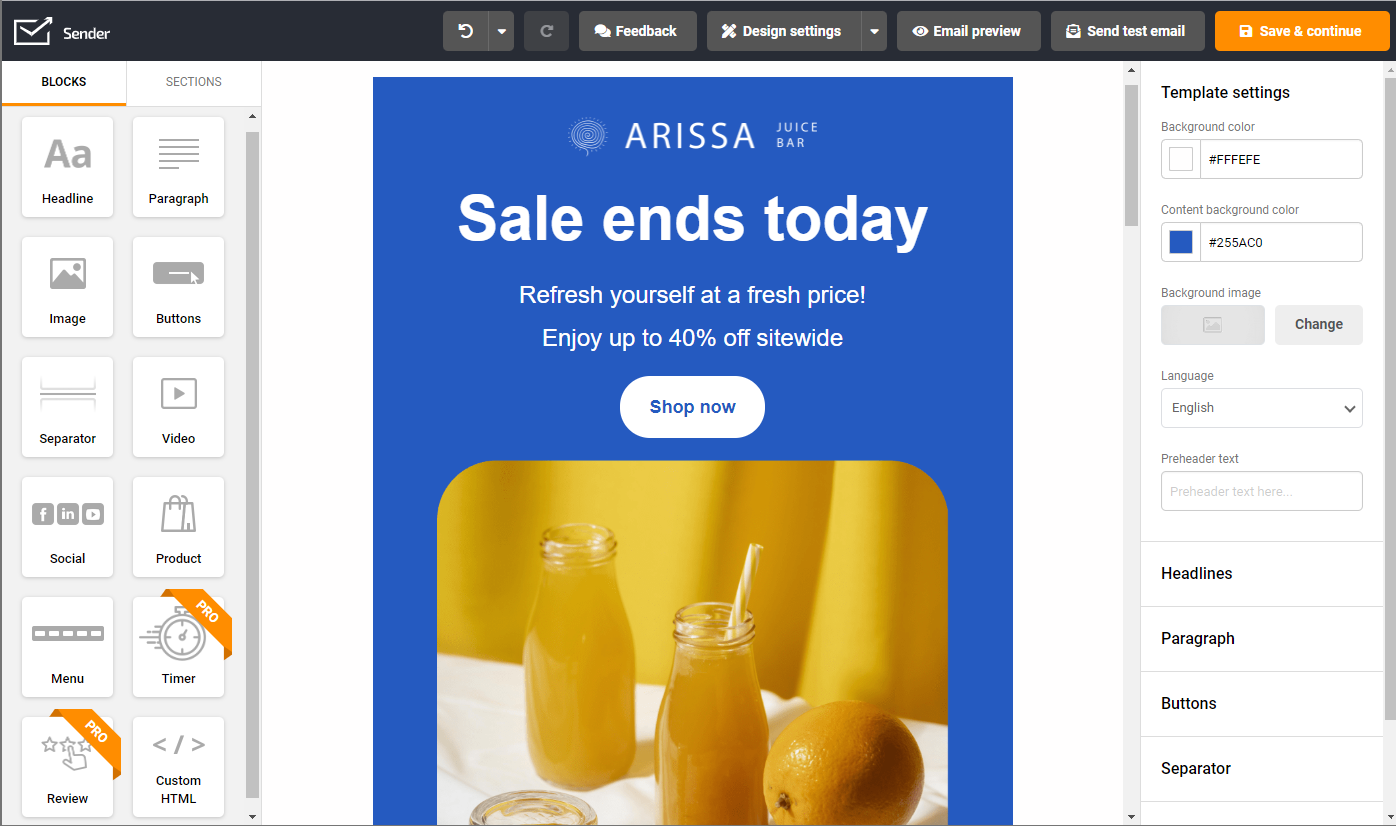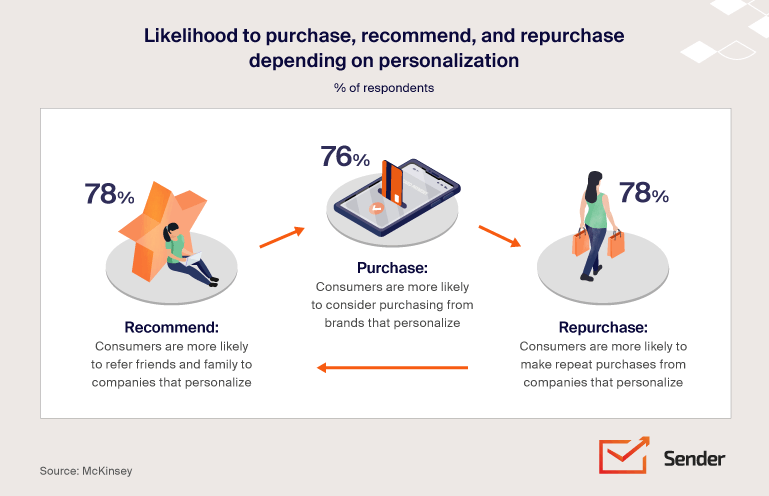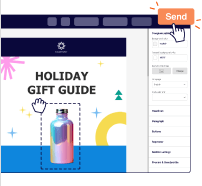Everyone’s sending marketing emails – you probably already have an email campaign marketing strategy on the books. But do you know how to keep your emails out of the spam folder?
That’s where email deliverability comes in. The effectiveness of email marketing depends on email deliverability, and it’s something that you may take for granted.
What is Email Deliverability?
The phrase “email deliverability” sounds complicated, but it’s actually something everyone with an email address interacts with every day. Email deliverability, not to be confused with inbox delivery rate, refers to how successfully an email reaches its intended recipient’s inbox vs spam folder (or any other archive that’s not the primary inbox).
Email deliverability is influenced by various factors ranging from the sender’s reputation to the complexities of email service providers’ (ESPs) algorithms. We’ll go over all of this at length, so don’t worry if it sounds like a lot!
Good email deliverability means your inbox placement rate is high, setting the foundation for email message engagement. On the other hand, poor email deliverability means messages still end up in the spam folder, even if you have the most meticulously crafted email campaign.
As such, understanding and optimizing email deliverability is important for any business that uses email marketing as a part of its digital strategy. So, let’s get started!
Why is Email Deliverability Important?
Email deliverability can affect email marketing campaigns in several ways:
- Reach and engagement: Did you know that 70% of marketers around the globe consider email campaigns to be effective? High email deliverability means more emails reach inboxes, leading to better engagement rates. These rates are crucial for nurturing leads and building relationships, which boosts conversions.
- Brand reputation and trust: Consistently landing in the inbox builds trust with your audience and creates a customer connection. Along with that, it shows that internet service providers recognize your brand as legitimate – and valuable! This makes email deliverability an important piece of your overall SEO strategy.
- Return on investment: Improved email deliverability leads to higher open and click-through rates. Boosting these rates gives you a higher return on investment, which is always the goal of any marketing campaign.
To break it down: Email deliverability ensures that your messages actually reach your audience, allowing you to communicate, engage, and convert.
Good email deliverability rates mean that your marketing efforts reach your intended audience, which maximizes the return on investment of email campaigns. All of these things work together to grow your business.
Sender makes sure your email campaigns reach the recipients’ inboxes. And it has all the features your business needs in one simple dashboard.

How Does a Good Email Deliverability Rate Look?
Good email deliverability is typically defined as having 95% or more of your emails successfully reach the recipient’s inbox. Along with that, you want to make sure your bounce rate isn’t higher than 3%.
A high level of email deliverability is a clear sign of effective email campaigns, which gets the ball in motion for email marketing success.
Deliverability Rate of Marketing Emails
Marketing emails like newsletters and promos usually get lower open rates up to 28%. And understandably so. They’re more likely to end up in spam folders due to the advanced filtering systems of email services like Gmail.
When more people are opening your emails, it’s a sign that your content is hitting the mark and actually matters to your audience. That’s why boosting your open rates should be at the top of your email marketing to-do list.
Deliverability Rate of Transactional Emails
Transactional emails like purchase order confirmations or password resets usually have much higher deliverability rates than regular marketing emails — a whopping 80-85%. That’s because they’re expected and often triggered by user actions.
Using email automation tools like Sender helps make sure these messages go out instantly and consistently, without you lifting a finger.
Plus, these tools are designed to route transactional emails separately from promotional messages, which helps preserve deliverability and avoid spam filters.
Understanding Your Deliverability Report
A strong email deliverability rate means little if you don’t understand email inbox placement — knowing whether your messages are actually reaching your target audience’s inbox.
This is where Inbox Placement Rate (IPR) comes in. Unlike the delivery rate, which only shows that an email hit the server, this metric tells you how many emails land in the primary inbox—not just somewhere in the mailbox, say ‘spam’ folder.
In order to calculate your IPR, all you need to do is divide the number of emails delivered to the inbox by the total number of emails sent. Say you send 100 emails and 25 of those made it to the inbox — this means your IPR is 25%. Generally, a good IPR is considered to be over 80%.
Since email providers don’t share this info, features like seed lists also help estimate the deliverability rate on dummy emails.
What Affects Email Deliverability?
Two of the biggest factors affecting email deliverability are email campaign content and sender reputation. Here’s the breakdown of why they matter:
Keeping track of your email campaigns and making sure you aren’t using phrasing in your subject line or email to trigger spam filters is the first step to email deliverability success. Also, be sure to use a reputable email client, especially if you have a large mailing list.
Email sender reputation is the most important driving force of email deliverability, as it shows service providers that your emails are legitimate. Deleting inactive subscribers from your list and maintaining your domain reputation will go a long way.
Avoiding spam traps isn’t difficult as long as you perform regular maintenance and choose your subject lines carefully.
Email deliverability isn’t the only factor you should be aware of. Check out 13 common email marketing mistakes and how to avoid them.
How to Test Email Deliverability?
Testing email deliverability is easy as pie. Send yourself an email from your business account, then see if your message hits your personal inbox on the first try. If you receive messages from your business, you likely have nothing to worry about.
If your email gets caught in your spam trap, make sure the sender address is clear and check for spam trigger phrases. Also, make sure to test the reputation of your business’s dedicated IP addresses and make improvements where needed.
While you’re at it, take a look at your overall email strategy. In 2024, leveraging advanced technologies like AI tools will become increasingly important. AI can suggest the best time to send an email, personalize content at scale, and optimize the subject line for higher open rates.
Check out our other tips below for avoiding the spam section of the inbox to pinpoint and resolve any spam issues.
Best Practices to Improve Email Deliverability
Now that you know what email deliverability is all about, you’re likely asking what you can do to have a good rate. Here are some email deliverability best practices to keep your messages out of the spam folder.
Incorporate New Google Spam Policies
Google has begun cracking down on spam emails, with new policies that started in February 2024. In addition to keeping track of your sender score, you’ll want to make sure that you’re taking email security seriously and set up SPF or DKIM verification, which we’ll talk about later.
The most important aspect of this update is that you’ll need to have a spam rate that’s less than 0.3%. So, do what you can to ensure that you keep spam complaints to a bare minimum. Google’s policies for businesses sending 5,000 emails a day also include making unsubscribing easy, which will help with this.
If you send over 5,000 emails a day, you’ll also want to make sure you set up DMARC authentication.
As of 2023, Gmail is the second most popular email service provider, so not following these new policies could affect email deliverability to a big portion of your mailing list. Along with this, since Google is unparalleled in industry leadership, you can likely expect other email providers to follow suit with these policies.
Sender Policy Framework
Think of Sender Policy Framework (SPF) like a bouncer at a club checking IDs. Your email domain owns the club, and only certain ‘servers’ are on the approved guest list. When an email is sent using your domain, the receiving server checks the SPF record to see if the sender’s server is allowed. If it’s on the list, the email gets through. If not, it gets marked as spam or results in email delivery failure.
Behind the scenes, your domain’s SPF record lives in your DNS and lists all the IP addresses or servers allowed to send emails for you. Every time an email is sent, the receiving system runs a quick check: ‘Is this sender legit?’ If the answer is yes, the email is trusted.
SPF is a vital part of email deliverability. It protects your domain reputation by not allowing it to get spoofed and builds trust with email providers. Without it, someone could send sketchy emails pretending to be you—hurting your SMTP server reputation and causing your real emails to land in spam as a result.
Domain Keys Identified Mail
DomainKeys Identified Mail (DKIM) is like a digital signature for your emails. It adds a special encrypted code to each message that proves it really came from your domain and wasn’t tampered with along the way.
DKIM plays a big role in email deliverability. It helps prevent phishing attempts or getting your messages being flagged as spam because it shows you’re a legit sender. Inbox providers like Gmail and Outlook rely on it (along with other tools) to decide whether to trust your email.
It’s often used alongside SPF, which works a bit differently. While SPF checks if the sending server has permission to send emails on behalf of your domain, DKIM verifies that the content hasn’t been altered and really came from you. Think of SPF as verifying ‘who’s allowed to send,’ while DKIM checks ‘was this email messed with on its way?’ Together, they boost your chances of landing in the inbox instead of the junk folder.
If you need some help setting SPF and DKIM up with your server provider’s DNS settings, you can find guides for the most common host providers on Sender’s step-by-step tutorial.
Domain-based Message Authentication, Reporting and Conformance
Domain-based Message Authentication, Reporting & Conformance (DMARC) is like the final checkpoint in your email security setup. While SPF verifies if the sending server is allowed to send on behalf of your domain, and DKIM ensures the message wasn’t tampered with, DMARC connects the dots.
It makes sure both checks align with your domain and tells email providers what to do if something doesn’t match—reject, quarantine, or let it through.
You add a DMARC record to your domain’s DNS settings, which signals to inbox providers that you’re taking authentication seriously. It also gives you visibility through reports, showing whether the sender is using your domain.
By having DMARC in place, your emails are more likely to be trusted by providers like Gmail, Outlook, and others. That trust translates into better deliverability—some sources claim that setting up DMARC can boost your email marketing deliverability up to 11%.
Sure, this might not seem like a lot. But in an industry where every email makes a difference, DMARC is something you don’t want to sleep on.
Strong Sender Reputation
Email sender reputation is how trustworthy internet and email service providers think your business is, and it’s influenced by a few moving parts. Sending habits, engagement from your mailing list, and reputation of IP addresses and domains all play a role in staying aligned with email deliverability best practices.
Signs of positive engagement include high open and click-through rates as well as low unsubscribe or spam complaint rates. Positive engagement means that you have good email content, which boosts your sender reputation and email deliverability rate. Engaging formats like video content will boost your open and click-through rates.
Domain reputation goes hand in hand with sender reputation. A positive domain reputation is a good safeguard against a mailbox provider marking your emails as spam messages.
However, if internet service providers detect sudden spikes in your email volume or low engagement, they may slow down delivery or even engage in email throttling. Not dealing with these issues swiftly may lead to a poor sender reputation.
Like domain reputation, your IP address reputation plays a role in your sender reputation. A dedicated IP address for your business will boost your inbox deliverability.
Your email deliverability rate will increase when internet service providers (ISPs) read your business as legitimate. So, all of these factors are important, even if it’s a lot to keep track of at once.
Email Filters
In addition to making sure your sender reputation is all set, you’ll also want to regularly go over your email list and filter out unknown users. Inactive subscribers can ding your sender reputation, which as you know, can affect your email deliverability rate.
As stated, Google is building easy unsubscription into its spam prevention policies, but it’s good practice anyway. Make sure there’s a clear unsubscribe link attached to each email you send.
It may seem strange to build unsubscription into your email strategy. But a healthy mailing list packed with active subscribers who engage with your emails paves the way for a solid deliverability rate. Plus, it may save you a bit of time from having to remove long-inactive subscribers yourself.
Email Personalization
Personalization in email marketing goes beyond addressing recipients by their names. It involves creating relevant content that suits your audience’s preferences, past interactions, and interests.
You can create relevant and personalized messages using purchase history, browsing behavior, and engagement patterns. High levels of email personalization makes each recipient feel valued and understood, which means they’ll be more likely to open your emails and make a purchase. After all, that’s what the endgame goal is, right?
When combined with segmentation, personalization becomes even more powerful. Dividing your email list into segments or smaller groups based on shared characteristics or behaviors allows for even more precise messaging. You can get this information from lead generation forms on your site, purchase history records, or localize your content based on region.
By using this approach, you’ll ensure that your emails are seen and meaningful to each recipient. When your emails are meaningful, it will boost engagement rates and skyrocket the revenue of your email campaigns.

Avoid Spam Folder Trigger Phrases
We all know spam trigger phrases – they usually lean on urgency and say things like “Buy today!” or “Take action!”. Most email marketers already know to avoid them, but just in case you need a refresher, keep your subject lines calm and personable. Meeting your audience where they’re at instead of being pushy will go a long way.
At the end of the day, as long as you’re engaging in email marketing in a legitimate way, you don’t have to worry too much about spam filter avoidance. Just be sure to only send marketing emails to people who have signed up for them, keep an eye on your sender’s reputation, and keep Google’s new policies in mind – then, you’ll be good to go.
Monitor Engagement Metrics
If you’re launching email campaigns without tracking how they perform, you’re basically flying blind. And your email marketing game is as good as the insights you pull from email deliverability monitoring.
Email engagement metrics like open rates, click-through rates, bounce rates, unsubscribe rates, and complaint rates (usually tracked through feedback loops) give you a real-time pulse on what’s working and what needs some fine-tuning.
These measures tell how your audience is engaging (or not) and help you spot certain email deliverability issues, A/B test campaigns, and adjust strategy before things can go off track. Ultimately, email delivery tracking on a day-to-day basis leads to healthier email deliverability.
Maintain a Consistent Sending Schedule
When it comes to email marketing, when you send can be just as important as what you send. Your subscribers are more likely to open your emails if they know when to expect them. In fact, studies show that marketers who send emails on a regular basis see up to 20% higher open rates.
Timing your emails right can also make a big difference in email deliverability. Sending emails at the right hour can seriously boost your open rates, click-throughs, and overall campaign deliverability. When one-in-five emails gets opened within the first hour, deciding when to hit ‘send’ isn’t just a detail – it’s a game-changer.
To make your life easier, check out this Sender’s guide and plan your email campaigns like a pro.
Clean and Validate Email Lists
Rockstars lose fans over time—sadly, your email list is no different. Users move on, change interests, or stop checking old inboxes, and if you keep shouting into the void by emailing them, it can hurt your email deliverability.
Low engagement and high bounce rates are key red flags for email service providers. That’s exactly why maintaining email hygiene is important. Spot inactive subscribers and try to win them back. Or, if they’re unresponsive, it’s time to ‘sunset’ them.
Using double opt-in helps ensure only engaged subscribers make it onto your list. And keeping an eye out for hard bounces or invalid addresses will make sure that your emails land in the inbox.
Warm Up Dedicated IP Addresses
IP warming is the process of slowly starting to send emails from a brand new IP address and gradually increasing its volume. Think of it as building up your IP reputation by demonstrating that you’re a legit sender, consistently sending emails people expect, and not a spammer jumping in out of nowhere.
You’re probably thinking that IP warming should come naturally, and you’re absolutely right. However, there are a couple of things you should keep in mind while getting on the email providers’ good books:
- Start by sending to your most engaged subscribers to establish a solid sender reputation;
- Stick to a consistent sending schedule to build credibility with inbox providers;
- Keep an eye on email bounce rates with deliverability tools and adjust your sending volume if things look off;
- Gradually expand your list as your IP gains trust, rather than ramping up too quickly.
Conclusion
Maintaining good email deliverability is essential for successful email marketing, but it’s not just about avoiding the spam filter.
- Email deliverability is about making sure your messages reach the right inboxes, engage your audience, and ultimately help you hit your desired results;
- Every aspect of your email strategy contributes to this goal, from personalizing content to using the right tools;
- With a focus on optimizing deliverability and providing valuable insights, Sender is an excellent solution for anyone looking to enhance their email strategy.






